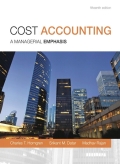
Concept explainers
What is broad averaging, and what consequences can it have on costs?
Broad Averaging:
Broad averaging is also known as peanut butter cost is a costing approach of distributing the overall overhead cost of resources on the average basis to the associate cost of product.
Indirect Cost or Overheads:
Indirect cost is that cost which cannot be directly identified with the manufacturing of a particular product.
To explain: Broad averaging and consequences of broad averaging on cost.
Answer to Problem 5.1Q
- Broad averaging is the costing approach of allocating the overall indirect cost of manufacture to the associated product cost. The use of this costing approach is to find out the estimate cost of a particular product.
- The consequence of broad averaging is that it does not tell the actual estimation cost of a product, it leads to over estimation or under estimation cost of a product.
Explanation of Solution
- Broad averaging helps to allocate the indirect cost or overhead cost of manufacture on the basis of percentage of total cost or on average basis to the associate cost of a product.
- A manufacture cannot determine the actual estimation cost of a product. The broad averaging costing approach leads to undervalued or overvalued the cost of a product.
Broad averaging helps to distribute the overhear cost and the consequences of broad averaging is that the cost of a product leads to over costing or under costing.
Want to see more full solutions like this?
Chapter 5 Solutions
Cost Accounting
Additional Business Textbook Solutions
Operations Management: Processes and Supply Chains (12th Edition) (What's New in Operations Management)
Business Essentials (12th Edition) (What's New in Intro to Business)
Financial Accounting: Tools for Business Decision Making, 8th Edition
Horngren's Accounting (12th Edition)
FUNDAMENTALS OF CORPORATE FINANCE
Principles of Operations Management: Sustainability and Supply Chain Management (10th Edition)
- Maria Patel's weekly gross earnings for the week ending October 21st were $2,850, and her federal income tax withholding was $520. Assuming the Social Security rate is 6.2% and Medicare is 1.45% of all earnings, what is Patel's net pay for Nexus Corporation? Need helparrow_forwardCan you provide a detailed solution to this financial accounting problem using proper principles?arrow_forwardPlease provide the correct answer to this general accounting problem using accurate calculations.arrow_forward
 Cornerstones of Cost Management (Cornerstones Ser...AccountingISBN:9781305970663Author:Don R. Hansen, Maryanne M. MowenPublisher:Cengage Learning
Cornerstones of Cost Management (Cornerstones Ser...AccountingISBN:9781305970663Author:Don R. Hansen, Maryanne M. MowenPublisher:Cengage Learning Managerial AccountingAccountingISBN:9781337912020Author:Carl Warren, Ph.d. Cma William B. TaylerPublisher:South-Western College Pub
Managerial AccountingAccountingISBN:9781337912020Author:Carl Warren, Ph.d. Cma William B. TaylerPublisher:South-Western College Pub Financial And Managerial AccountingAccountingISBN:9781337902663Author:WARREN, Carl S.Publisher:Cengage Learning,
Financial And Managerial AccountingAccountingISBN:9781337902663Author:WARREN, Carl S.Publisher:Cengage Learning, Principles of Cost AccountingAccountingISBN:9781305087408Author:Edward J. Vanderbeck, Maria R. MitchellPublisher:Cengage Learning
Principles of Cost AccountingAccountingISBN:9781305087408Author:Edward J. Vanderbeck, Maria R. MitchellPublisher:Cengage Learning College Accounting, Chapters 1-27 (New in Account...AccountingISBN:9781305666160Author:James A. Heintz, Robert W. ParryPublisher:Cengage Learning
College Accounting, Chapters 1-27 (New in Account...AccountingISBN:9781305666160Author:James A. Heintz, Robert W. ParryPublisher:Cengage Learning Managerial Accounting: The Cornerstone of Busines...AccountingISBN:9781337115773Author:Maryanne M. Mowen, Don R. Hansen, Dan L. HeitgerPublisher:Cengage Learning
Managerial Accounting: The Cornerstone of Busines...AccountingISBN:9781337115773Author:Maryanne M. Mowen, Don R. Hansen, Dan L. HeitgerPublisher:Cengage Learning





